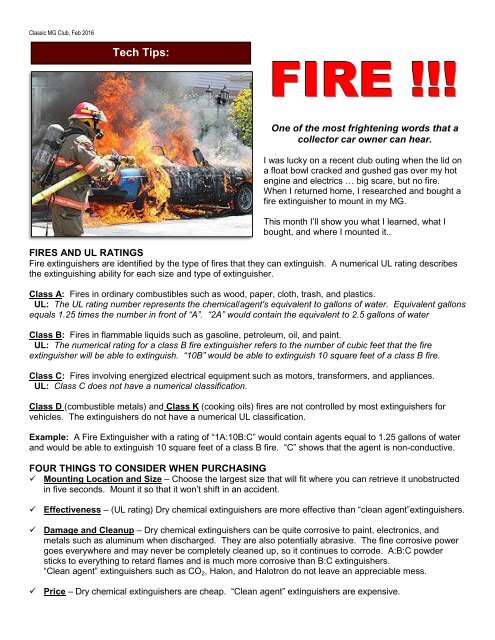TT_02-2016_FireExtinguishers
How to choose a fire extinguisher for a collector car
How to choose a fire extinguisher for a collector car
You also want an ePaper? Increase the reach of your titles
YUMPU automatically turns print PDFs into web optimized ePapers that Google loves.
Classic MG Club, Feb <strong>2016</strong><br />
Tech Tips:<br />
FIRE !!!<br />
One of the most frightening words that a<br />
collector car owner can hear.<br />
I was lucky on a recent club outing when the lid on<br />
a float bowl cracked and gushed gas over my hot<br />
engine and electrics … big scare, but no fire.<br />
When I returned home, I researched and bought a<br />
fire extinguisher to mount in my MG.<br />
This month I’ll show you what I learned, what I<br />
bought, and where I mounted it..<br />
FIRES AND UL RATINGS<br />
Fire extinguishers are identified by the type of fires that they can extinguish. A numerical UL rating describes<br />
the extinguishing ability for each size and type of extinguisher.<br />
Class A: Fires in ordinary combustibles such as wood, paper, cloth, trash, and plastics.<br />
UL: The UL rating number represents the chemical/agent's equivalent to gallons of water. Equivalent gallons<br />
equals 1.25 times the number in front of “A”. “2A” would contain the equivalent to 2.5 gallons of water<br />
Class B: Fires in flammable liquids such as gasoline, petroleum, oil, and paint.<br />
UL: The numerical rating for a class B fire extinguisher refers to the number of cubic feet that the fire<br />
extinguisher will be able to extinguish. “10B” would be able to extinguish 10 square feet of a class B fire.<br />
Class C: Fires involving energized electrical equipment such as motors, transformers, and appliances.<br />
UL: Class C does not have a numerical classification.<br />
Class D (combustible metals) and Class K (cooking oils) fires are not controlled by most extinguishers for<br />
vehicles. The extinguishers do not have a numerical UL classification.<br />
Example: A Fire Extinguisher with a rating of “1A:10B:C” would contain agents equal to 1.25 gallons of water<br />
and would be able to extinguish 10 square feet of a class B fire. “C” shows that the agent is non-conductive.<br />
FOUR THINGS TO CONSIDER WHEN PURCHASING<br />
Mounting Location and Size – Choose the largest size that will fit where you can retrieve it unobstructed<br />
in five seconds. Mount it so that it won’t shift in an accident.<br />
Effectiveness – (UL rating) Dry chemical extinguishers are more effective than “clean agent”extinguishers.<br />
Damage and Cleanup – Dry chemical extinguishers can be quite corrosive to paint, electronics, and<br />
metals such as aluminum when discharged. They are also potentially abrasive. The fine corrosive power<br />
goes everywhere and may never be completely cleaned up, so it continues to corrode. A:B:C powder<br />
sticks to everything to retard flames and is much more corrosive than B:C extinguishers.<br />
“Clean agent” extinguishers such as CO 2 , Halon, and Halotron do not leave an appreciable mess.<br />
Price – Dry chemical extinguishers are cheap. “Clean agent” extinguishers are expensive.
VEHICLE FIRE EXTINGUISHER COMPARISON<br />
[ CLICK ] for catalog<br />
TYPE B:C DRY CHEM A:B:C DRY CHEM PURPLE K HALON HALOTRON CO2<br />
AGENT<br />
sodium<br />
monoammonium potassium bicarbonate<br />
bicarbonate<br />
phosphate + chemical additives<br />
Halon 1211 Halotron 1 CO2<br />
UL @ 15” X 3” 10B:C 1A:10B:C 10B:C 5B:C 2B:C size N/A<br />
CAPACITY 2.5 lb 2.5 lb 2.5 lb 2.5 lb 2.5 lb size N/A<br />
UL @ 15” X 4¼”<br />
10B:C<br />
2A:10B:C<br />
40B:C - hose 3A:40B:C - hose<br />
30B:C - hose 10B:C 5B:C 2B:C - hose<br />
CAPACITY 5 & 5.5 lb 5 lb 5 lb 5 lb 5 lb 2.5 lb<br />
DAMAGE<br />
corrosion, elec, high corrosion, less corrosion(?), elec,<br />
engine<br />
paint, elec, engine<br />
engine<br />
none none none<br />
CLEANUP difficult very difficult difficult light or none light or none none<br />
PRICE $ $ $$$ $$$$$ $$$$$ $$$$$<br />
SO WHAT DID I BUY?<br />
My objective was the largest “clean agent” extinguisher that would fit into my car. Joe Fry at United Fire<br />
Protection, 2900 Shader Road in Orlando, (407) 299-<strong>02</strong>01 guided me toward my objective.<br />
I bought a 2-1/2 pound reclaimed Halon extinguisher. It’s 14-3/8” hi X 3” diam. Unfortunately, nothing<br />
larger would fit where I could reach it fast and unobstructed. The UL rating is 5B:C. Halon is less effective<br />
than dry chemical agents … hope that the small capacity doesn’t just make the fire mad instead of<br />
extinguishing it. A five pound Halon extinguisher would have been perfect.<br />
Note: New Halon extinguishers are no<br />
longer available because it depletes the<br />
ozone. Less effective, ozone friendly<br />
Halotron replaced Halon. Halon from old<br />
extinguishers can be reclaimed and<br />
used.<br />
I mounted it just in front of and parallel to<br />
the front of the passenger seat. It sits<br />
under the passenger’s legs. I can<br />
retrieve it in less than five seconds.<br />
HOW TO USE<br />
Turn off the lights, accessories, and ignition to stop the fuel pump. A typical fire extinguisher contains 10<br />
seconds of extinguishing power. Shoot the stream at the base of the fire, not at the flame. Sweep from side to<br />
side until the fire is completely out. Start using the extinguisher from a safe distance away, then move forward.<br />
Once the fire is out, keep an eye on the area in case it re-ignites.<br />
Next Month:<br />
MG OWNERS SURVIVAL GUIDE<br />
What to do in a medical emergency, by John Spadaro, Chief Fire Officer / Paramedic (Ret.)<br />
Lonnie Cook<br />
lonniecook@aol.com<br />
TF7211



